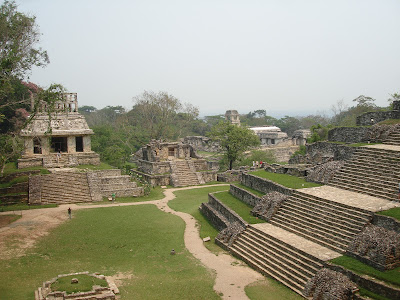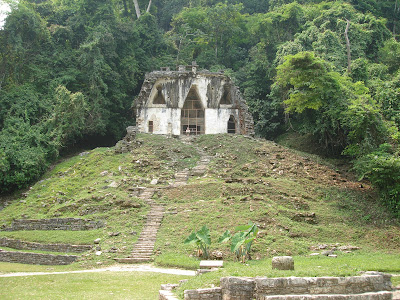Our second Mayan ruins stop was Chichen Itza in Yucatan, which is considered to be among the "Seven Wonders of the Modern World." Palenque, which we visited the week before, had set the bar pretty high (See: Palenque Part Two - More gods more problems) so we were excited to see Chichen Itza, the crown jewel of Mayan ruins in Mexico. We arrived to Chichen Itza town mid-day and found the suitable, if rustic, Stardust Inn. We then proceeded to watch lousy American movies all afternoon. It was around 105 degrees, and neither of us really felt like walking down the scorching, dusty streets while tour buses coated us with diesel fumes and road grime. Apparently because of the "seven wonders" status, Chichen Itza has shown up on the international tourism radar in a big way, and the two lane main street entertains constant streams of 50 foot tour buses heading both directions for most of the daylight hours.
The funny part was, the town itself didn't have any tourist foot traffic. The buses seemed to come in from somewhere else, wait around town all day, and head back out around 6pm. I believe that the mega-destination status must have caused this, and looked to have caught the local merchants and hotel owners by surprise. The main strip was rife with funky, unique looking 1960s looking courtyard hotels, but with the now grand perception of the site outshining them, they had become just another strange, dust covered thing to take a picture of from the bus window. Somehow, though, I don't have any pictures of our hotel, or any of the others...sorry! They were really cool, though run down, and reminded me of the motels you see along the sides of old highways the outskirts of towns in the U.S. (but with palm trees)
Though there were two tour buses in the parking lot of the "Stardust Inn", when we arrived, upon entering the courtyard it was apparent that we were the only guests in the 60 room hotel. The owner explained that the tour buses would be parked in front of the door until four, after which we were welcome to pull our bike into the lobby. I guess at four they drive back out, pick up the tourists at the ruins, and ferry them back to Merida or Cancun - never to set foot in town. The only lodging in the area which appeared to be occupied was a couple of brand new four and five star "eco-resorts" a few miles out of town, whose appearance and amenities (apparently) better suited the new class of visitor. As far as we could tell, two people worked at the Stardust: the owner who spoke English, and another guy who took care of everything else. The pool was too murky to swim in, the palm trees around it were fading fast, and, by the noises it emitted, our air conditioner seemed to be fighting for its very life. But they were all still there, and obviously doing their best to hold on. The situation presented itself most clearly when, as we were checking out, the "everything else" man was attempting to get an ancient electric pool vacuum to run. As I made trips back and forth to the bike with our tons of luggage, he rewired the plug, spliced it onto a longer cord, taped up the connections, and searched for an electrical outlet that would make it run. Once it was running the task ahead of him became painfully clear, as its 4 inch nozzle was nowhere near up to the massive task of cleaning out the horribly murky water in the 20 by 40 foot pool. Though, as we finished packing and said goodbye, he was giving it his best effort; lying on his stomach, his arms thrust shoulder-deep into the murky water, earnestly scrubbing at the algae to little avail. What else could he do?
So, the ruins. The ruins were a series of grand buildings which, because of the falling deaths of two tourists, you were not allowed to touch, let alone climb. On the dusty, flat ground in between them you could sweat profusely and buy all manner of Chinese jewelry, knick-knacks and tee-shirts. At the grand ball court we met a tour group from Mexico City, and their guide, who spoke English, invited me to play the traditional ball game with them. He asked me if I spoke English, and when I said I did, everyone chuckled and he explained the entire game in Spanish. Then, while “playing”, he continued his comedy routine by repeatedly yelling "gringo!" at me to the delight of his fans. We then stood relatively near a few pyramids and took photos inadvertently featuring a number of random tourists and knick knack sales people.(Who, we had been told in Merida, were not really even Mayan, let alone Artisans)
 |
| Jill and some new friends |
The fate of the local businesses is quite sad, and having been to Palenque we understood what was being lost. In becoming world famous Chichen Itza seems to have sacrificed the charm of places like the Stardust Inn. As massive as the ruins were, there is more to a destination than its monuments.
Go to Palenque.
To be fair, the night "light show" did give us an opportunity to take some neat photos, but was only in Spanish with no translation available.
 |
| $10 photo op! |













